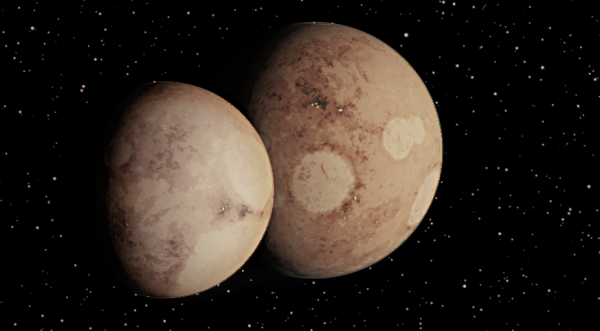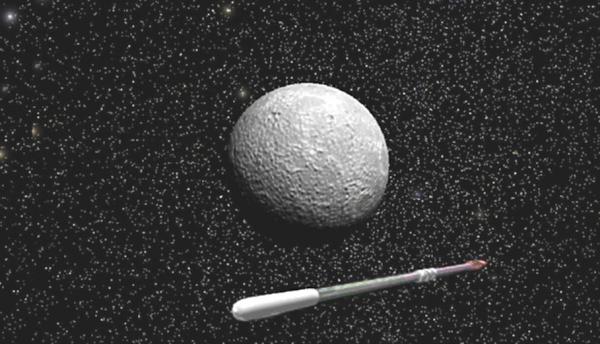BY LETTER
LithicGelidian Type
_
Cold Terrestrial Class worlds that form or migrate beyond the snowline of a solar system, sometimes becoming free-floating Stevensonian worlds.
LithicGelidian worlds have a rocky core with an extensive icy mantle, usually with water ice as the predominant component. Often a surface layer of nitrogen ice, carbon dioxide or monoxide ice, and/or methane ice is also present. These worlds range in colour from pale grey to reddish-brown, depending on the composition of the surface layers.
The surfaces of these worlds are sometimes heavily cratered, though many show signs of past or present geologic activity due to tidal stressing or other global factors. These planets often have tenuous atmospheres which are replenished by low or moderate levels of geological activity.
Planetoid class: moons, dwarf planets and other objects that are formed into spheroidal shape by gravity, and which are less than 0.05 as massive as Earth. In these objects the rocky material is mostly found in the core, overlaid by varying amounts of ice.
Terrestrial class Planets with 0.05 to 2.5 x Earth's mass. These objects have larger rocky cores than Ymirian class worlds, and often have surface rocky outcrops.
Superterrestrial class lithicgelidian worlds, between 2.5 and 10 Earth masses, may have moderately thick atmospheres, but do not hold enough volatiles to become a gas giant. Superterrestrial lithicgelidian worlds are rare.
Some icy worlds acquire quite considerable populations. Deuterium in the ice can supply enough energy via fusion to warm a limited number of terraformed domes for a considerable period, and more advanced methods of energy production such as conversion reactors can heat the entire surface to above melting point. In due course the planet can become a water world, often with some rocky continents.
Even without conversion power the surface of a lithic-gelidian world can be heated using solar power, if this power could be focused sufficiently well. A swarm of weather machines or other mirrors in orbit around the planet can heat the surface; alternately a class 2 sunline or similar arrangement around the local star can collect light and direct it straight towards the frozen worlds in its system.
Icy worlds of this type are often colonised by Hiders or by the Deeper Covenant; others are colonised by factions from the major Sephirotic Empires, often in systems where the inner worlds are already populated.
Examples: Merrion, Galatea, Pluto
Worlds with a rocky core and an extensive icy mantle. | |
 Image from Steve Bowers | |
| Ramesh and Aartie, twin lithic-gelidian worlds which exert tidal forces on each other, causing low to moderate levels of geological activity | |
LithicGelidian worlds have a rocky core with an extensive icy mantle, usually with water ice as the predominant component. Often a surface layer of nitrogen ice, carbon dioxide or monoxide ice, and/or methane ice is also present. These worlds range in colour from pale grey to reddish-brown, depending on the composition of the surface layers.
The surfaces of these worlds are sometimes heavily cratered, though many show signs of past or present geologic activity due to tidal stressing or other global factors. These planets often have tenuous atmospheres which are replenished by low or moderate levels of geological activity.
Size classes
Asteroid class: these objects are too small to collapse into a spherical form, and tend to consist of rubble-piles including both ice and rock.Planetoid class: moons, dwarf planets and other objects that are formed into spheroidal shape by gravity, and which are less than 0.05 as massive as Earth. In these objects the rocky material is mostly found in the core, overlaid by varying amounts of ice.
Terrestrial class Planets with 0.05 to 2.5 x Earth's mass. These objects have larger rocky cores than Ymirian class worlds, and often have surface rocky outcrops.
Superterrestrial class lithicgelidian worlds, between 2.5 and 10 Earth masses, may have moderately thick atmospheres, but do not hold enough volatiles to become a gas giant. Superterrestrial lithicgelidian worlds are rare.
Colonisation of LithicGelidian worlds
 Image from Steve Bowers | |
| Merrion, an icy world with numerous transparent dome-habitats | |
Even without conversion power the surface of a lithic-gelidian world can be heated using solar power, if this power could be focused sufficiently well. A swarm of weather machines or other mirrors in orbit around the planet can heat the surface; alternately a class 2 sunline or similar arrangement around the local star can collect light and direct it straight towards the frozen worlds in its system.
 Image from Steve Bowers | |
| Galatea in the Beta Coma Berenices system | |
Examples: Merrion, Galatea, Pluto
Appears in Topics
Development Notes
Text by John M. Dollan in his Planet Classification List
Amended by Steve Bowers and Vik-Thor (may 2013)
Initially published on 03 December 2001.
Amended by Steve Bowers and Vik-Thor (may 2013)
Initially published on 03 December 2001.






